

MEAN.io - A Fullstack Javascript Framework. AngularJS Directives in Traction. AngularJS is a super-heroic JavaScript Framework that makes writing single page applications a breeze.
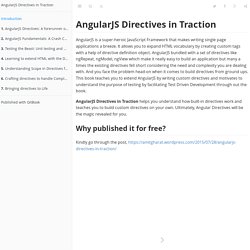
It allows you to expand HTML vocabulary by creating custom tags with a help of directive definition object. AngularJS bundled with a set of directives like ngRepeat, ngModel, ngView which make it really easy to build an application but many a times the existing directives fell short considering the need and complexity you are dealing with. And you face the problem head-on when it comes to build directives from ground ups. This book teaches you to extend AngularJS by writing custom directives and motivates to understand the purpose of testing by facilitating Test Driven Development through out the book.
Exploring ES6. Learning JavaScript Design Patterns. Design patterns are reusable solutions to commonly occurring problems in software design.
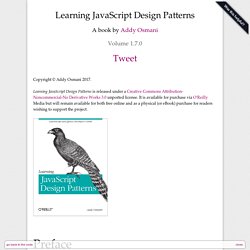
They are both exciting and a fascinating topic to explore in any programming language. One reason for this is that they help us build upon the combined experience of many developers that came before us and ensure we structure our code in an optimized way, meeting the needs of problems we're attempting to solve. Design patterns also provide us a common vocabulary to describe solutions. This can be significantly simpler than describing syntax and semantics when we're attempting to convey a way of structuring a solution in code form to others.
In this book we will explore applying both classical and modern design patterns to the JavaScript programming language. Target Audience This book is targeted at professional developers wishing to improve their knowledge of design patterns and how they can be applied to the JavaScript programming language. Acknowledgments Credits Reading. Read JavaScript Allongé, the "Six" Edition. JavaScript Garden. Although JavaScript deals fine with the syntax of two matching curly braces for blocks, it does not support block scope; hence, all that is left in the language is function scope. function test() { // a scope for(var i = 0; i < 10; i++) { // not a scope // count } console.log(i); // 10} There are also no distinct namespaces in JavaScript, which means that everything gets defined in one globally shared namespace.

Each time a variable is referenced, JavaScript will traverse upwards through all the scopes until it finds it. In the case that it reaches the global scope and still has not found the requested name, it will raise a ReferenceError. The Bane of Global Variables // script Afoo = '42'; // script Bvar foo = '42' The above two scripts do not have the same effect. Again, that is not at all the same effect: not using var can have major implications. // global scopevar foo = 42;function test() { // local scope foo = 21;}test();foo; // 21 Local Variables. Dive Into HTML5. Introduction. GitHub - tcorral/javascript-challenges-book: Challenge yourself learning and understanding the most obscure and tricky parts of Javascript.
Writing Modular JavaScript With AMD, CommonJS & ES Harmony. When we say an application is modular, we generally mean it's composed of a set of highly decoupled, distinct pieces of functionality stored in modules.
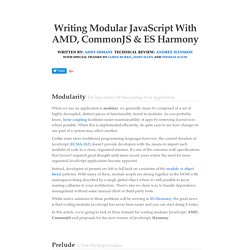
As you probably know, loose coupling facilitates easier maintainability of apps by removing dependencies where possible. When this is implemented efficiently, its quite easy to see how changes to one part of a system may affect another. Unlike some more traditional programming languages however, the current iteration of JavaScript (ECMA-262) doesn't provide developers with the means to import such modules of code in a clean, organized manner. It's one of the concerns with specifications that haven't required great thought until more recent years where the need for more organized JavaScript applications became apparent.
Instead, developers at present are left to fall back on variations of the module or object literal patterns. Today it's embraced by projects including Dojo (1.7), MooTools (2.0), Firebug (1.8) and even jQuery (1.7). App.js. Programming JavaScript Applications. Copyright © 2014 Eric Elliott Printed in the United States of America.
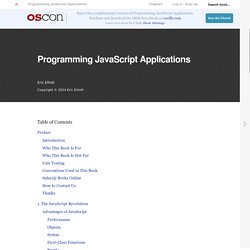
O’Reilly books may be purchased for educational, business, or sales promotional use. Online editions are also available for most titles ( For more information, contact our corporate/institutional sales department: 800-998-9938 or <corporate@oreilly.com>. Nutshell Handbook, the Nutshell Handbook logo, and the O’Reilly logo are registered trademarks of O’Reilly Media, Inc. Programming JavaScript Applications, the image of an argali, and related trade dress are trademarks of O’Reilly Media, Inc. Many of the designations used by manufacturers and sellers to distinguish their products are claimed as trademarks. While every precaution has been taken in the preparation of this book, the publisher and author assume no responsibility for errors or omissions, or for damages resulting from the use of the information contained herein.
You-Dont-Know-JS/README.md at master · getify/You-Dont-Know-JS. JS Objects: Inherited a Mess. JS Objects: TL;DR JavaScript has been plagued since the beginning with misunderstanding and awkwardness around its "prototypal inheritance" system, mostly due to the fact that "inheritance" isn't how JS works at all, and trying to do that only leads to gotchas and confusions that we have to pave over with user-land helper libs.
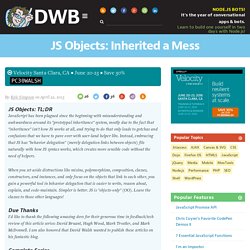
Instead, embracing that JS has "behavior delegation" (merely delegation links between objects) fits naturally with how JS syntax works, which creates more sensible code without the need of helpers. When you set aside distractions like mixins, polymorphism, composition, classes, constructors, and instances, and only focus on the objects that link to each other, you gain a powerful tool in behavior delegation that is easier to write, reason about, explain, and code-maintain. Simpler is better. GitHub - maxogden/art-of-node: a short introduction to node.js. JavaScript Enlightenment.